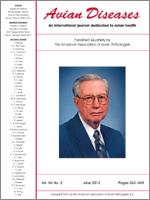Egyptian geese (Alopochen aegypticus), a duck species endemic to sub-Saharan Africa and occasionally implicated in the transmission of avian influenza viruses (AIV) to farmed ostriches, were experimentally infected with low pathogenicity H7N1 and H6N8 viruses to assess viral shedding and immune profiles. Following the first infection with H7N1 virus, high titers of virus were shed from both the tracheae and cloacae for at least 7 days postinfection, and tracheal shedding lasting until day 14. All detectable shedding from both tracheae and cloacae had ceased within 28 days of infection. Antibody titers peaked at day 7 postinfection, but the initial immune response was short-lived. Birds that received a second challenge with the homologous H7N1 virus mounted a more robust response that lasted beyond 66 days postchallenge, and H7N1 virus was detected, albeit at much lower levels, until day 28 post secondary infection (psi) in the cloaca and beyond day 28 psi in the trachea. Birds that received an initial infection with H7N1 virus were also challenged with H6N8 virus, and because a comparable shedding pattern to the H7N1 challenge group was observed, we concluded that the effect of any nonspecific immunity was negligible.
Respuesta de anticuerpos y perfil de eliminación viral de gansos egipcios (Alopochen aegyptiacus) infectados con virus de la influenza aviar de baja patogenicidad subtipos H7N1 y H6N8.
Gansos egipcios (Alopochen aegyptiacus), una especie de patos endémicos de África subsahariana y que en ocasiones se han asociado con la transmisión del virus de la influenza aviar a granjas de avestruces, fueron infectados experimentalmente con virus de influenza aviar de baja patogenicidad subtipos H7N1 y H6N8 para evaluar la diseminación viral y el perfil inmunológico. Después de la primera infección con el virus H7N1, se observó una eliminación de títulos virales altos a partir de dos tráqueas y cloacas por lo menos durante siete días post-infección, y la diseminación traqueal que duró hasta el día 14. La detección de eliminación tanto de tráqueas como de cloacas se terminó dentro de los 28 días de la infección. Los títulos de anticuerpos alcanzaron su punto máximo en el día siete después de la infección, pero la respuesta inmune inicial fue de corta duración. Las aves que recibieron un segundo desafío con el virus homólogo H7N1 establecieron una respuesta más robusta que se prolongó más allá de los 66 días después del desafío, y se detectó el virus H7N1, aunque con niveles mucho más bajos, hasta que 28 días después de la infección secundaria en la cloaca, y en la tráquea más allá del día 28 después de la infección secundaria. Las aves que recibieron una infección inicial con el virus H7N1 fueron desafiados también con el virus H6N8, y debido a que se observó un patrón de eliminación comparable a la del grupo desafiado con el subtipo H7N1, se concluyó que el efecto de cualquier mecanismo inmune inespecífico fue insignificante.





